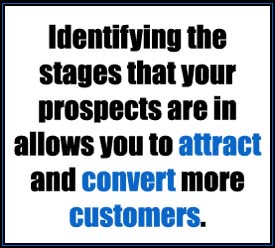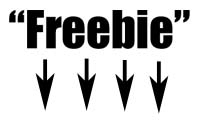5 Stages Of How A Prospect Becomes A Customer

- Stage 1 – Future prospect – He fits the general profile of someone who could become a customer one day. He is mostly unaware that a product like yours is even in existence. He doesn’t yet realize that one day he will become your targeted prospect.
- Stage 2 – Cold Prospect– He is aware that products like yours exist but does not feel any real need for any of them yet.
- Maybe he doesn’t understand how it will benefit him
- He might not believe it will benefit him enough to be worthwhile
- Or else he doesn’t feel like he needs that benefit
- Stage 3 – Warm prospect – He recognizes a need to own a product that provides a benefit like yours does and starts becoming more aware of anything he might come across that fulfills that benefit. He will probably be purchasing a product like yours or finding some other way to fulfill that benefit within the next year or less.
- Stage 4 – Hot Prospect – He is actively seeking information about how to obtain the benefit you offer or he is shopping around for a place to buy it. He will be making a purchase as soon as today or within a reasonably short period of time.
- Stage 5 – Customer – He pulls the trigger and makes a purchase from you.
How does The Prospect Evolution Theory apply to a real life situation? Read the following story and it will explain how.
A story about a man who needs life insurance
 George is a recently married, thirty something year old, handsome man with a beautiful wife Linda. They are a typical couple who is ready to settle down and start having a family. They just purchased their first home and are in the process of customizing that new home by putting their own special touches on it.
George is a recently married, thirty something year old, handsome man with a beautiful wife Linda. They are a typical couple who is ready to settle down and start having a family. They just purchased their first home and are in the process of customizing that new home by putting their own special touches on it.
George doesn’t realize it yet, but he is a perfect Stage 1 Future Prospect for a life insurance company. Unbeknownst to George, at some point in his future he is going to start thinking about getting life insurance. George hasn’t even given it a thought yet though.
Ahh…..Married life…….
The first six months of their new lives together pass by for George and Linda pretty quickly. They are enjoying the good life that every newly married couple goes through right after they tie the knot. One night, George and Linda are sitting down to have a nice chicken dinner. Linda gives George a really serious but somewhat nervous look and springs some big news on him. After a few moments of awkward silence, she tells him that she is pregnant.
The two embrace each other, hugging each other tightly, and exchange “I love You’s”. Life is about to get a lot different for that couple.
One Saturday (during the time when Linda is still pregnant) George is sitting on his couch having a beer catching a Notre Dame College football game. During half time, a commercial comes on television talking about life insurance. The commercial catches his attention. It talks about how every man who has a family should really have life insurance just in case the unexpected happens. George thinks about it for a minute because he knows he has a kid on the way, but he ends up brushing it off. He figures he is too young and too healthy to worry about such things. “Life insurance is for old people” he thinks to himself. George has just moved into Stage 2 as a prospective life insurance client. He is a Cold Prospect.
George is aware that life insurance companies exist and he knows why they exist. But, something keeps him from seriously considering getting a policy. He doesn’t yet realize how much a policy could benefit him. Maybe he just doesn’t think it is worth the hassle or worth paying the annual premium for. Maybe he just doesn’t feel like he needs to worry about it at all. If a life insurance salesman were to cold call him on the phone right now, George would probably hang up on him. Either that or he is going to just be thinking “blah, blah, blah,” the whole time the salesman is talking. That sales guy is going to seem like he is being somewhat of a pest to George.
Happy Birthday!
 Finally the big day has arrived. Linda gives birth to their first son, Henry. Right then and there, George experiences one of the most profoundly life changing moments ever. He sees his son for the first time. He hears the little guy cry. George stares at him in awe and disbelief that something so awesome could have possibly just happened. His life will never be the same.
Finally the big day has arrived. Linda gives birth to their first son, Henry. Right then and there, George experiences one of the most profoundly life changing moments ever. He sees his son for the first time. He hears the little guy cry. George stares at him in awe and disbelief that something so awesome could have possibly just happened. His life will never be the same.
The first couple months pass quickly. George and Linda are very busy feeding baby Henry and changing his diapers. One sunny Saturday afternoon, George is taking in another one of his Notre Dame games on television. That same commercial that he saw a couple months before comes on again. The commercial talks about life insurance and about how every responsible father should have a policy to protect his family “just in case”. This time, the message of the commercial hits home with George a little bit. Now he thinks “Holy crap! What if something did happen to me? How would Linda raise our child on her own? Would Henry be able to go to college? How would Linda pay the mortgage? Holy crap!”
The experience leaves a burning feeling in George’s gut. It is going to be a monkey on his back from now on until he does something about it. George tries to shrug off the thought of something bad happening to his family. He manages to do that for a little while. Yet, it won’t go away completely. That monkey keeps tapping him on the shoulder from time to time when he is holding baby Henry. He keeps reminding himself that he needs to do something about this inadequate sense of security. Deep down George knows that he should have some life insurance just in case.
What you are witnessing is the process of George evolving from a stage 2 life insurance “cold prospect” and becoming a Stage 3 Warm Prospect. Learning about life insurance is now kind of important for George. Now when he sees an insurance company commercial on television, he starts paying attention to what the company’s name is and what their website is. He wants to check them out. He is now becoming familiar with the various company names that are commonly associated with insurance of any type, but most especially the ones associated with life insurance.

One evening after dinner while they are enjoying some family time together, George decides to fire up his laptop and do some research. He starts up his computer and goes to Google. He types the phrase “How much does life insurance cost” into Google. Google then shows him a bunch of ads for life insurance companies. Below the ads are links to a bunch of articles about life insurance. George realizes there is a lot to learn. He clicks on a couple of those articles. He does some reading and thinking about it, but refuses to make a decision. George likes to really understand what he is doing when he makes a big purchase like this. He doesn’t yet feel like he really knows what he is doing. He closes his computer and goes to bed. While lying in bed he is pondering what he just learned about.
A couple days later, while at work, George is sitting at his desk taking his lunch break. Usually when he is eating his lunch at his desk like this, he spends time kind of screwing around on the internet or checking his personal Yahoo email account. This time is no different.
He is on his Yahoo email page when an advertisement for cheap life insurance catches his eye. He clicks on the ad and reads what the offer is all about. The ad just takes him to a spot where it asks George to provide a whole bunch of information to get a quote on life insurance. George isn’t the type of guy who likes to give away personal information, especially to some generic form on a website that he knows nothing about. He doesn’t know where that information is going to ultimately end up. So, he passes on that offer and goes back to work.
Another month goes by and George still hasn’t gotten this monkey off of his back. He is still bothered by the idea that he isn’t providing enough security for his beautiful bride and his perfect baby boy. It nags at him like a very subtle but sometimes noticeable dull aching pain. He gets a little pit in his stomach every time he thinks about it.
Sitting at his desk one day, George gets a text message on his cell phone from Linda. The text message reads that Linda just heard that one of George’s close friends from back in high school, Jeff, was just injured in a really bad car accident. The guy could have been killed, but thankfully he wasn’t.
 George thinks to himself “Oh my God! Poor Jeff!” Then another thought hits him –“Oh man! What if that was me……what if I got killed?” That is it. George just moved up from being a stage 3 warm prospect into a Stage 4 Hot Prospect. At that very moment, he decides that he can’t put this life insurance thing off any longer. He has to do something about it very soon.
George thinks to himself “Oh my God! Poor Jeff!” Then another thought hits him –“Oh man! What if that was me……what if I got killed?” That is it. George just moved up from being a stage 3 warm prospect into a Stage 4 Hot Prospect. At that very moment, he decides that he can’t put this life insurance thing off any longer. He has to do something about it very soon.
Instead of tapping on his shoulder, that monkey on his back is now slapping George upside his head nagging him to get some insurance.
If a life insurance salesman was to cold call George now, George would listen closely to his every word. He would catch the words dripping from the salesman’s lips as if they were drops of honey. George would listen with both ears, fully engaged in the conversation.
But that salesman doesn’t call at that moment and George isn’t going to wait for one to call. George promises himself that this weekend he is going to make a decision and get some life insurance.
Saturday rolls around and George is going to keep the promise he made to himself. He is going to do something about getting life insurance. He is going to do something today. George grabs his laptop and fires it back up. He doesn’t want to read articles about insurance any more. Now he wants to actually shop around seriously. This time he goes to Google and types “best life insurance rates for 30 year old”.
Google shows him a bunch of ads and some more links to articles. George quickly browses the ads and ends up clicking on the very first advertisement he saw. He clicked on that first one because the ad said that it had the lowest rates and best coverage for a family with a newborn baby. As soon as he saw “best coverage for family with a newborn”, he was hooked. He calls the company and gets the ball rolling on getting an exact policy quote for a guy like him.
If that company says the right things and makes it appear like a good deal, George is going to move to Stage 5 where he becomes a Customer of that company. That last company ended up winning the sale because they had what appeared to be the perfect product for George.
——————–
This is just one example of how a prospect goes through every stage of evolution before becoming a customer. There were a lot of different possible outcomes that could have happened there. George could have made different choices. The life insurance companies could have done a better job of impressing him early on as he evolved from stage 2 to stage 3 or from stage 3 to stage 4.
What if one of those companies that George had investigated back when he was in stage 3 had offered to mail George a free guide about finding the perfect insurance policy. George may have given them his name and address and maybe even more information like his email address or telephone number. Then what if that company had followed up on that lead every few months, reminding George that they were there for him whenever he finally decided to get serious about life insurance? Would they have been able to turn him into a new client?
What if a life insurance company had convinced George’s wife Linda that this company had the best life insurance policy for a family like theirs? And what if they had convinced Linda to pressure George into buying life insurance sooner? Could that company have earned that family’s business? Could Linda have been considered a Stage 1 Future Prospect too way back when she and George were first married or even when they got engaged? Could she have been targeted using completely different tactics?
Why Bother Classifying Prospects Into Stages Like This?
 The reason why you want to classify your prospects like this is because it makes your marketing and advertising much more effective. It helps you to target your prospects ten times better. By thinking about what stage your prospect is in, you discover what is going on inside their minds. Understanding what is going on inside the head of your customer is the key to tapping into their wallets. It allows you to position your company, your website, your products and your services in such a way so that they become more desirable to the prospect.
The reason why you want to classify your prospects like this is because it makes your marketing and advertising much more effective. It helps you to target your prospects ten times better. By thinking about what stage your prospect is in, you discover what is going on inside their minds. Understanding what is going on inside the head of your customer is the key to tapping into their wallets. It allows you to position your company, your website, your products and your services in such a way so that they become more desirable to the prospect.
Stage 4 Hot Prospects are obviously the cream of the crop when it comes to making sales. You wish that everyone who comes to your website or comes in contact with your business is one of these stage four super hot prospects who is ready to buy right now. Those prospects are out there.
The way you want to approach selling to a stage 4 prospect and the way you approach selling to a different stage prospect will be different because their minds are in different places.
In stage four you want to immediately convince (or have already previously convinced) the prospect that you have the most ideally suited product at the best value and that you will deliver it in a manner that is fast and painless. That will get them to buy from you.
In order to appeal to a prospect when they are at Stage 2 or Stage 3 (cold prospect or warm prospect) you can’t just go around trying to tell them you have the cheapest, highest quality product with the best delivery. They don’t care. They aren’t looking to buy from you yet. Your message of being the cheapest or being the best isn’t going to sink in very well. It will fall on deaf ears.
This is why there is so much advertising that doesn’t work. If you are bringing stage 2 and stage 3 prospects into your website by using social media campaigns, Facebook ads or Google Display network ads and they aren’t converting, it might be because you are shoving stage 4 marketing content in front of them upon arrival. These prospects just aren’t going to respond to that marketing message yet. They aren’t ready yet.
To target a stage 2 prospect, you want to target them through education. You want to teach that person why any product like yours (not just your product, but anyone’s similar product, even competitors’) would be useful to him. He isn’t shopping for anything yet. So if you just try to convince him that your product is better than your competition, it isn’t going to work well. He just doesn’t care yet. He won’t care about that until he reaches a later stage in the buying process.
To target a stage 3 prospect you want to target him through education too. You want to teach that person how to shop for products like yours and similar to yours. Teach him how to make an intelligent buying decision. Teach him what matters about products and services like yours. What separates a high quality product from a low quality product? What separates a high value product from a low value product? What factors should a person pay the most attention to in order to be really happy with their purchase later on?
These stage 2 and stage 3 prospects will likely respond well if you give them this education for free. You can give away free reports, free guides, educational videos, newsletters, etc. all in an effort to teach that prospect what he needs to know about your industry as it relates specifically to him. In the process of doing that, you are going to be warming that prospect up from stage 2 to stage 3 and stage 3 to stage 4. Guess who that person is most likely to do business with if you are speaking to him as he converts from stage 3 to stage 4?
The Prospect Evolution Theory Explains Why Certain Forms of Marketing and Advertising Will Succeed While Others Will Fail
The prospect evolution theory explains why email marketing works over the long run. You are maintaining contact with that prospect as he evolves into a stage 4 prospect.
This theory also explains why content marketing works over the long run. You are converting stage 2 prospects to stage 3 prospects and converting stage 3 prospects into stage 4 prospects as they digest your information.
It explains why some forms of Pay Per Click advertising can be exceptionally profitable while the same campaign ran elsewhere can lose money. It explains the difference between advertising in the Google Search Network versus the Google Display Network. It explains the difference between Google Search Network advertising and Facebook Advertising. It explains the difference between Search Network advertising and any form of embedded media pay per click advertising.
The theory explains why SEO can generate immediate sales when you target the right keywords and yet can result in zero sales when targeting the wrong keywords.
If you take time to analyze the evolutionary process of your customers, you will make all of your promotional efforts more effective. It is your secret weapon for building much more effective promotional campaigns that are much more profitable.






